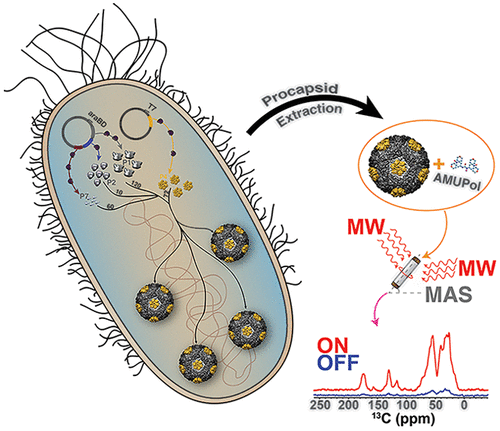当前位置:
X-MOL 学术
›
Biochemistry
›
论文详情
Our official English website, www.x-mol.net, welcomes your feedback! (Note: you will need to create a separate account there.)
Sequential Protein Expression and Capsid Assembly in Cell: Toward the Study of Multiprotein Viral Capsids Using Solid-State Nuclear Magnetic Resonance Techniques
Biochemistry ( IF 2.9 ) Pub Date : 2018-02-21 00:00:00 , DOI: 10.1021/acs.biochem.8b00003 Sébastien Alphonse 1 , Boris Itin 2 , Reza Khayat 1, 3 , Ranajeet Ghose 1, 3, 4
Biochemistry ( IF 2.9 ) Pub Date : 2018-02-21 00:00:00 , DOI: 10.1021/acs.biochem.8b00003 Sébastien Alphonse 1 , Boris Itin 2 , Reza Khayat 1, 3 , Ranajeet Ghose 1, 3, 4
Affiliation

|
While solid-state nuclear magnetic resonance (ssNMR) has emerged as a powerful technique for studying viral capsids, current studies are limited to capsids formed from single proteins or single polyproteins. The ability to selectively label individual protein components within multiprotein viral capsids and the resulting spectral simplification will facilitate the extension of ssNMR techniques to complex viruses. In vitro capsid assembly by combining individually purified, labeled, and unlabeled components in NMR quantities is not a viable option for most viruses. To overcome this barrier, we present a method that utilizes sequential protein expression and in cell assembly of component-specifically labeled viral capsids in amounts suitable for NMR studies. We apply this approach to purify capsids of bacteriophage ϕ6 isotopically labeled on only one of its four constituent protein components, the NTPase P4. Using P4-labeled ϕ6 capsids and the sensitivity enhancement provided by dynamic nuclear polarization, we illustrate the utility of this method to enable ssNMR studies of complex viruses.
中文翻译:

蛋白质在细胞中的顺序表达和衣壳组装:使用固态核磁共振技术的多蛋白病毒衣壳研究
固态核磁共振(ssNMR)已成为研究病毒衣壳的强大技术,但目前的研究仅限于由单一蛋白质或单一多蛋白形成的衣壳。选择性标记多蛋白病毒衣壳内单个蛋白成分的能力以及由此产生的光谱简化将促进ssNMR技术向复杂病毒的扩展。体外对于大多数病毒而言,以NMR量组合单独纯化的,标记的和未标记的组分来组装衣壳并不是可行的选择。为了克服这一障碍,我们提出了一种方法,该方法利用蛋白质的顺序表达和在组件中特异性标记的病毒衣壳的细胞装配中以适合NMR研究的量使用。我们采用这种方法来纯化仅在其四个组成蛋白成分之一NTPase P4上同位素标记的噬菌体ϕ6的衣壳。使用P4标记的ϕ6衣壳和动态核极化提供的灵敏度增强,我们说明了该方法的实用性,可用于复杂病毒的ssNMR研究。
更新日期:2018-02-21
中文翻译:

蛋白质在细胞中的顺序表达和衣壳组装:使用固态核磁共振技术的多蛋白病毒衣壳研究
固态核磁共振(ssNMR)已成为研究病毒衣壳的强大技术,但目前的研究仅限于由单一蛋白质或单一多蛋白形成的衣壳。选择性标记多蛋白病毒衣壳内单个蛋白成分的能力以及由此产生的光谱简化将促进ssNMR技术向复杂病毒的扩展。体外对于大多数病毒而言,以NMR量组合单独纯化的,标记的和未标记的组分来组装衣壳并不是可行的选择。为了克服这一障碍,我们提出了一种方法,该方法利用蛋白质的顺序表达和在组件中特异性标记的病毒衣壳的细胞装配中以适合NMR研究的量使用。我们采用这种方法来纯化仅在其四个组成蛋白成分之一NTPase P4上同位素标记的噬菌体ϕ6的衣壳。使用P4标记的ϕ6衣壳和动态核极化提供的灵敏度增强,我们说明了该方法的实用性,可用于复杂病毒的ssNMR研究。



























 京公网安备 11010802027423号
京公网安备 11010802027423号